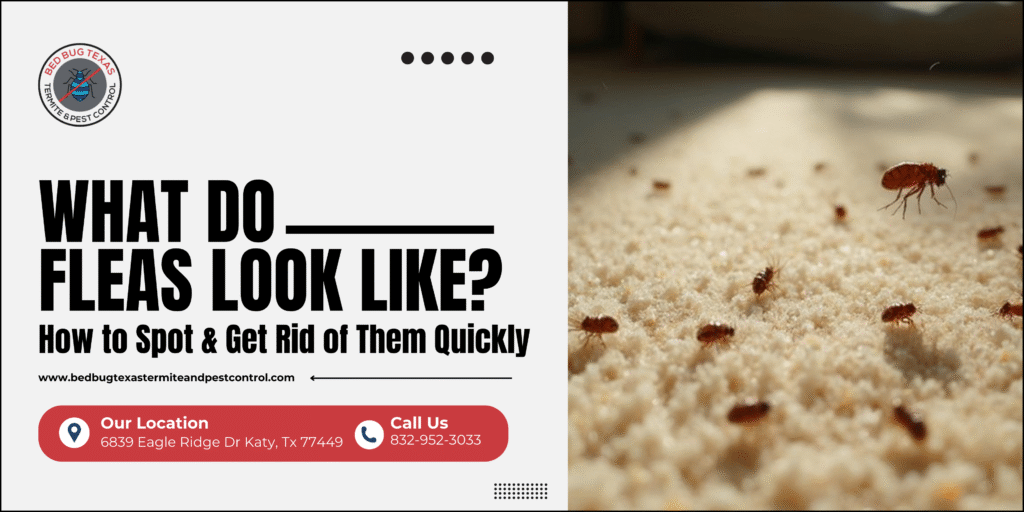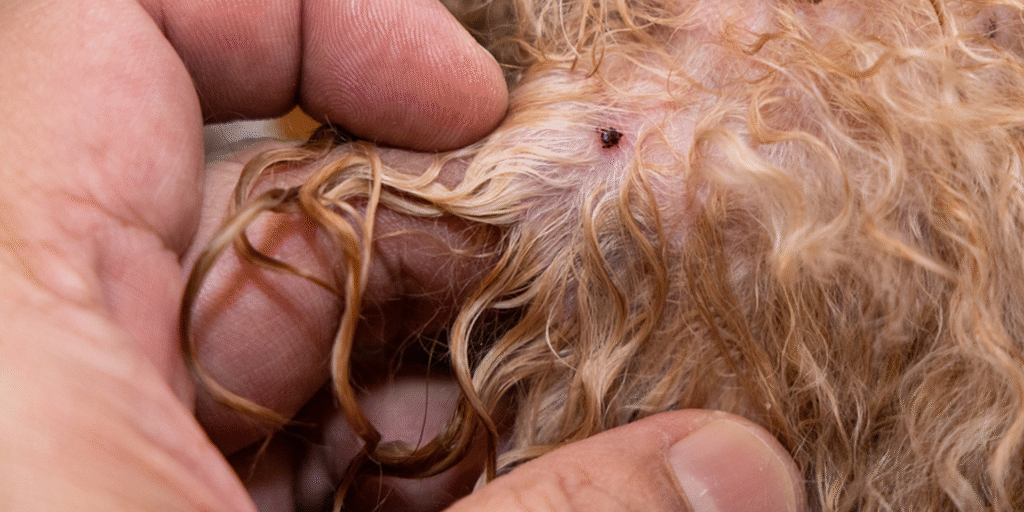
If your dog is itching like crazy out of nowhere or you’ve seen tiny jumpers on the carpet, you’re probably dealing with fleas. They’re tiny, stubborn little pests that, once they settle in, spread fast. This guide shows you what fleas look like at every stage and, more importantly, how to get rid of fleas in a way that actually works in real homes, not just on a product label.
What Do Fleas Look Like?
- Adults:. Adult fleas are about 1-3 mm long, dark brown to almost black, and flattened side-to-side so they slide through fur and carpet fibers. They don’t fly, but they jump like little springs. If you have light-colored pets or flooring, you’ll spot them faster.
- Baby Fleas (larvae): Baby fleas look completely different from adults. They are tiny, white, thread-like worms (about 2-5 mm). They avoid light and burrow deep into carpets, bedding, and floor cracks. If you’re only seeing “little white worms,” that’s larvae and not carpet lint.
- Eggs and pupae: Flea eggs are white, oval, and smaller than a grain of salt. They slide off your pet and end up in carpets, creases, and pet beds. Pupae are hidden in sticky cocoons that cling to dust, so you almost never see them. They just “appear” as fresh adults days or weeks later.
Why Fleas Are Extremely Hard to Get Rid Of?
A single female flea can lay dozens of eggs a day. Those eggs fall everywhere your pet goes, and the life cycle is roughly 28 days under normal home conditions. If you only kill adults, you’ll feel great for about three days, then a new wave hatches. The trick is to break the cycle across eggs, larvae, pupae, and adults.
Flea Treatments That Actually Work And What Doesn’t
- Flea Bombs: Flea bombs look and sound very dramatic. Foggers like this can’t force insecticide deep into carpet creases, baseboard gaps, and flooring joints where fleas nest and larvae hide.
- Vinegar and Baking Soda Spray: Vinegar and baking soda sprays may repel a bit, but it doesn’t reliably kill adults, larvae, or eggs. They are just not worth the effort in our opinion.
- Borax Powder: This one actually works quite well. It dehydrates fleas and their eggs, and with the right routine, it can deliver 100% results in a budget-friendly way. If you’re searching for how to get rid of fleas without dropping a fortune, this is it.
How to Use Borax to Eliminate Fleas From Your Home?
1. Vacuum First
This is the most important step. Go slow along wall edges, under furniture, and in door and baseboard creases. Fleas usually gather in those tight spots. As soon as you finish, empty the vacuum outside into a sealed bag and bin it immediately.
2. Even Application of Borax
Pour borax into a table salt shaker and lightly sprinkle over carpets, rugs, and anywhere pets rest. Do not overdo it, as it piles on top and can get vacuumed away before it can work.
3. Work it in
Use a stiff brush to scrub the powder down into the fibers and especially into the creases near walls, door thresholds, and around furniture feet. The goal is to reach the same places larvae hide.
4. Let it sit
Leave it down for a full week. Don’t vacuum it up the next day. The dehydration takes time, and you want it in place as eggs hatch. Keep kids and pets off treated areas as much as possible.
5. Vacuum, Bin, Repeat
After a week, vacuum thoroughly and dispose of the contents outdoors in a sealed bag. Then reapply borax the same way. Repeat weekly for a full month to eliminate the fleas completely. Stopping early is how infestations bounce back.
Remember to keep borax away from kitchen counters, fish tanks, and curious mouths. Avoid over-application if pets or kids contact the floor. For cats and dogs, limit access to heavily treated rooms until you vacuum up.
But if you’re still seeing fleas after weeks of effort, or if doing all of this sounds like way too much hassle, then it’s time to call the professionals. Pest control experts can wipe out the infestation faster with treatments designed to stop fleas at every stage.
What If Flea Infestation Has Spread to the Flooring and Tiles?
Getting rid of fleas on tile or wooden floors can be trickier. Fleas love hiding in the gaps between floor tiles and cracks near walls. Borax can still help if you work it into those gaps, but you may need to step it up.
A stronger option is Propoxur 20% EC. It is an insecticide that doesn’t just kill fleas but also cockroaches, termites, and even mosquitoes that enter the house. It’s a heavy-duty solution, so follow the instructions closely.
Flea Treatment For Pets

Home treatments fail if fleas are coming back from your pets. Here’s what you should do:
- Flea Treatment for Dogs: Flea shampoos can be used for quick relief. Use vet-approved topical treatments, oral meds, or safe flea collars only.
- Flea Treatment for Cats: Cats are sensitive to chemicals. So, only use products specifically labeled for cats. Spot-ons and certain collars from reputable brands work well when used correctly.
- Regular Grooming: Comb your pets with a fine-tooth flea comb. Dip the comp in soapy water to drown the fleas you collect.
Extra Tips to Prevent Fleas From Coming Back
- Wash Bedding Regularly: Both pet and human bedding should be washed in hot water once a month.
- Vacuum Daily During Infestation: This is especially important in high-traffic areas, pest-resting spots, and under furniture.
- Do a Mini Borax Touch-Up: If you’ve had a bad infestation before, sprinkle some borax in problem corners every few months.
- Flea Comb Pets: After park or beach days, remember to flea comb your pet to keep everything clear.
Bottom Line
So, now you know what fleas look like. But spotting them is only the first step. The real challenge is to learn how to get rid of them for good. Forget those gimmicks like vinegar sprays or essential oils. If you want results, borax powder is one of the cheapest and most effective flea killers you can use at home.
And if you are still spotting them despite your best efforts, that’s your cue to bring in a professional flea killer. They use industrial-grade treatments that stop fleas at every life stage, saving you weeks of trial and error.
Frequently Asked Questions
- Are fleas visible to the human eye?
Yes, fleas are visible to the human eye. Adult fleas are very small, usually about 1/8 inch long, and appear as tiny dark brown or reddish-brown insects. They move quickly and can jump, which often makes them harder to spot. While you may see them on your pet’s fur, bedding, or furniture, their eggs and larvae are much harder to detect without close inspection.
- What smell do fleas hate?
Fleas hate strong scents like lavender, peppermint, eucalyptus, citronella, rosemary, and cedarwood. These smells can deter them but won’t fully eliminate an infestation.
- Can fleas live in carpets?
Yes, fleas can live in carpets. They often hide in carpet fibers, where they lay eggs and develop into larvae. Warm, dark areas of carpets provide the perfect environment for fleas to thrive until they find a host.
- Do flea bugs bite people?
Yes, fleas bite people. They feed on blood, usually leaving small, red, itchy bumps on the skin, often around the ankles, legs, or waistline. While they prefer pets, fleas will bite humans if no animal host is available.
- Can fleas live in human hair?
No, fleas don’t live in human hair in the way they do on furry animals.
